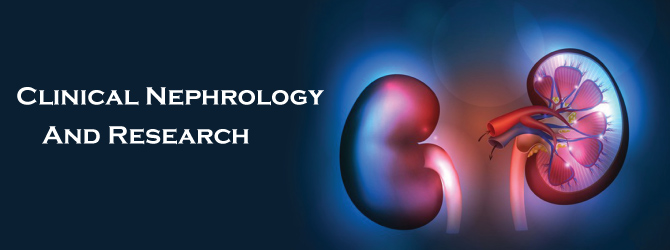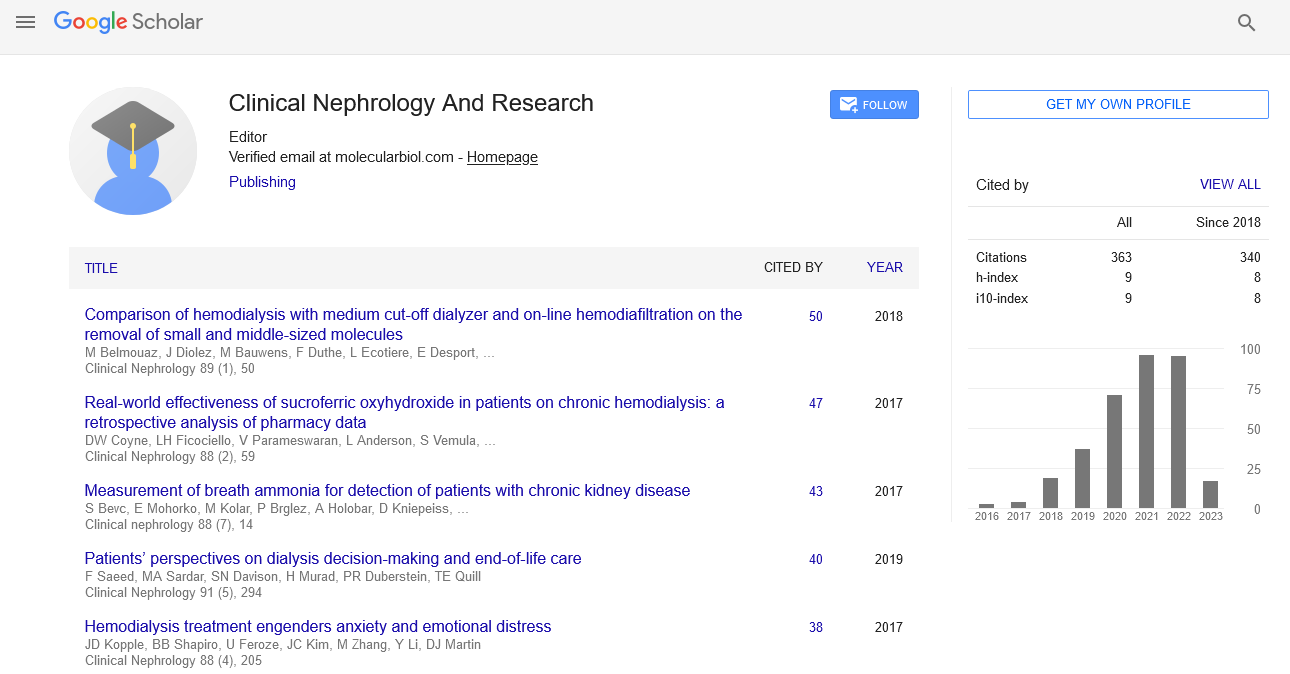Following ESUR recommendations, the French nephrology societies and the French radiological society have a shared perspective on the kidney and contrast media
Received: 01-Jan-2024, Manuscript No. PULCNR-24-6009; Editor assigned: 02-Jan-2024, Pre QC No. PULCNR-24-6009 (PQ); Reviewed: 16-Jan-2024 QC No. PULCNR-24-6009; Revised: 01-Mar-2024, Manuscript No. PULCNR-24-6009 (R); Published: 08-Mar-2024
Citation: de Laforcade C. Following ESUR recommendations, the French nephrology societies and the French radiological society have a shared perspective on the kidney and contrast media. Clin Nephrol Res 2023;7(1):1-2.
This open-access article is distributed under the terms of the Creative Commons Attribution Non-Commercial License (CC BY-NC) (http://creativecommons.org/licenses/by-nc/4.0/), which permits reuse, distribution and reproduction of the article, provided that the original work is properly cited and the reuse is restricted to noncommercial purposes. For commercial reuse, contact reprints@pulsus.com
Abstract
Contrast medium injection is customarily thought to cause or exacerbate renal failure, although current research may temper this claim. Recent guidelines from the European society of urogenital radiology evaluated the safety measures before delivering contrast media. As long as the benefit risk ratio supports it, administering iodinated contrast medium is not contraindicated in the presence of kidney injury. The only proven method to avoid post iodine contrast nephropathy is intravenous hydration with sodium bicarbonate or 0.9% NaCl. When the glomerular filtration rate is less than 30 mL/min/1.73 m2, when the glomerular filtration rate is less than 45 mL/min/1.73 m2, or in patients with acute renal failure, it is necessary to do this when administering an iodinated contrast agent intravenously or intra arterially without first renal pass. The use of iodinated contrast medium should allow for the execution of pertinent investigations based on a benefit risk analysis and the use of preventative measures where appropriate.
Keywords
Contrast media; Kidney failure; Chronic kidney injury; Tomography; X-ray computed; Magnetic resonance imaging
Introduction
The traditional causes of acute kidney damage include administering iodine based contrast media. As a result, iodinated CM injection is commonly restricted or avoided in patients who have kidney illness, which lowers the accuracy of imaging methods. Our understanding of renal toxicity and CM tolerance has increased over the past few years thanks to a number of significant articles. Regarding the management of CM and the avoidance of its adverse effects, the European Society of Urogenital Radiology (ESUR) has produced guidelines [1,2].
Conflicting opinions about the possibility of injecting CM into patients with kidney disease are frequently seen in practice [3]. Therefore, there is considerable interest in the dissemination of these findings and recommendations in clinical and radiology departments. Here, a working group made up of representatives from the major French nephrology and radiological societies suggests a commentary on the most recent ESUR guidelines.
Literature Review
PC-AKI risk factors specific to patients
The most important risk factor for PC-AKI is a preexisting decline in renal function. With declining baseline GFR, PC-AKI risk rises. Other risk factors have been discovered by numerous studies, most of which are observational: diabetes, heart failure, anaemia, age >75 years, female gender, history of significant cardiovascular events, cancer (particularly multiple myeloma), and inflammation. These are AKI risk factors, however they are not particular to the situation where CM is administered.
The working group identified pre existing CKD, AKI (known or suspected), and significant extracellular volume depletion as the patient related risk factors for PC-AKI. Age and other traditional risk variables, including diabetes, are not included since they are factors related to renal failure that has already occurred rather than independent risk factors. The imaging procedure's risk factors could possibly be a factor in PC-AKI. They included the use of high osmolality CM (often no longer used today), several injections of CM during the previous 48 or 72 hours, high doses of CM delivered intra arterially with first-pass renal exposure, and cardiovascular intervention [4,5]
Managing the treatment of patients
When an injection of iodinated CM is scheduled in a patient who is at risk for PC-AKI, it is critical to further restrict the use of therapies that could be nephrotoxic. Therefore, only therapies that are absolutely necessary should require continued administration of these drugs. Patients with CKD generally shouldn't receive these treatments.
Although not always nephrotoxic medications, ACE inhibitors and angiotensin receptor blockers have received the greatest research attention when used as PC-AKI therapies. These studies had a small patient population and presented inconsistent findings. Seven Randomised Controlled Trials (RCT) were combined in a meta-analysis, but it was unable to show that patients who continued using these RAAS inhibitors had an elevated risk of PC-AKI [6]
It seems appropriate to hold back and, if feasible, stop using NSAIDs in patients who are due to have an iodinated CM injection. If the benefit/risk ratio is negative, maintenance might be an option. The data is not strong enough to suggest stopping other therapies before administering CM.
Dialysis
Iodinated CM is cleared more slowly in patients with severe CKD. The efficiency of hemodialysis or hemofiltration can be affected by a variety of variables, including blood and dialysate flow rates, the length of the dialysis session, and membrane composition. If prolonged continuous hemofiltration procedures are not used, which is not usually practical, CM removal is still rather modest. In patients receiving 1 L of NaCl 0.9% during peritoneal dialysis, diuresis and residual clearance are maintained two weeks after CM administration, and after one month, according to reports from a small patient series. After coronary angiography, 1 in 24 participants in a third study had anuria.
A study in patients receiving chronic hemodialysis found no differences in residual function or diuresis 6 months after CM treatment as compared to a control group. Dialysis patients have a higher risk of thyroid dysfunction, however there is uncertainty regarding a possible connection between this risk and receiving several administrations of iodinated CM in this situation.
After the administration of iodinated CM, a hemodialysis appointment is not required. Intravenous hydration may be given to peritoneal dialysis patients to preserve their remaining kidney function. Intravenous hydration does not help chronic hemodialysis patients.
Discussion
Gadolinium Based Contrast Agents toxicity (GBCA)
Depending on the indication, GBCA for magnetic resonance imaging may be a better option than iodinated CM. GBCA are hyperosmolar solutes, including iodinated CM, whose renal clearance depends on glomerular filtration rate and which can build up in the presence of impaired kidney function. Patients who received dosages more than 0.2 mmol/kg and had known risk factors for AKI, such as CKD or diabetes, have been linked to possible nephrotoxicity, particularly following intra arterial injection. Because the research that produced these findings was conducted on people at risk for AKI, the causal relationship is still unclear (diabetes, CKD, absolute or effective hypovolemia, nephrotoxic drugs). GBCA is utilised in current practice at dosages of less than 0.2 mmol/kg, yet there is no proof that these amounts are harmful to the kidneys.
Nephrogenic Systemic Fibrosis (NSF) has only ever been documented in advanced renal disease patients who got linear GBCA and had an eGFR less than 30 mL/min/1.73 m2. Since the use of linear GBCA was discontinued in Europe in 2018, the risk has almost completely vanished. Regardless of the degree of renal function, today's approved products (gadoterate meglumine, gadobutrol, gadoteridol, and gadobenic acid) are no longer thought to provide a risk for NSF. This is supported by a recent meta-analysis that looked at patients with stage IV or stage V CKD and found that nonlinear GBCA had a risk of NSF of less than 0.1%. Dialysis does not lower the risk of NSF, regardless of the procedure.
Conclusion
The most recent ESUR recommendations advocate a greater use of iodinated CM in patients with kidney disease based on an updated review of the evidence. Priority should be placed on efficient and pertinent imaging procedures, the use of CM where appropriate, and the identification of patients who are at risk and need advance planning. Patients who have impaired renal function, such as those with AKI or CKD with GFR less than 45 mL/min/1.73 m2 for intra-arterial contrast media injection with renal first pass or GFR less than 30 mL/min/1.73 m2 in all other circumstances, are at risk. Reduced GFR is not necessarily a contraindication to the administration of CM if it is truly necessary and cannot be replaced by another diagnostic method, regardless of the stage of AKI/CKD. The optimal method of intravenous hydration for people at risk of PC-AKI is sodium bicarbonate 1.4% or NaCl 0.9%. No medication has demonstrated to be successful in preventing PC-AKI. After CM administration, a hemodialysis appointment is not required. These guidelines need to be spread throughout the nephrological and radiological communities.
References
- van der Molen AJ, Reimer P, Dekkers IA, et al. Post contrast acute kidney injury part 1: Definition, clinical features, incidence, role of contrast medium and risk factors: Recommendations for updated ESUR contrast medium safety committee guidelines. Eur Radiol. 2018;2845-55.
- van der Molen AJ, Reimer P, Dekkers IA, et al. Post contrast acute kidney injury. Part 2: Risk stratification, role of hydration and other prophylactic measures, patients taking metformin and chronic dialysis patients: Recommendations for updated ESUR contrast medium safety committee guidelines. Eur Radiol. 2018;28:2856-69.
- Khwaja A. KDIGO clinical practice guidelines for acute kidney injury. Nephron Clinical Practice. 2012;120(4):179-84.
[Crossref] [Googlescholar] [PubMed]
- Klahr S, Levey AS, Beck GJ, et al. The effects of dietary protein restriction and blood-pressure control on the progression of chronic renal disease. N Engl J Med. 1994;330(13):877-84.
[Crossref] [Google Scholar] [PubMed]
- Levey AS, Stevens LA, Schmid CH, et al. A new equation to estimate glomerular filtration rate. Ann Intern Med. 2009;150(9):604-12.
- de Sante HA. Evaluation of glomerular filtration rate and dosage of creatinine in the diagnosis of chronic kidney disease in adults. Bio Tribune Magazine. 2011;41(1): 6-9.





